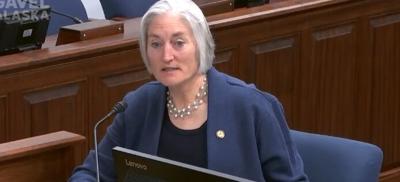A bill that would drastically increase the amount of state money spent on public education is being considered in the Alaska Legislature.
House Bill 69 would see Alaska’s base student allocation, the money each school district receives on a per student basis, increase by more than $1,800 over three years.
The bill is authored by Sitka Rep. Rebecca Himshcoot and cosponsored by Fairbanks Rep. Maxine Dibert.
“Because we have not provided stable and predictable funding, our schools are under immense pressure,” Dibert said in her newsletter on Sunday.
“Alaskans need to make it clear to their legislators and our governor that it’s time to fix this underfunding problem or we will continue to lose more families who leave Alaska for other states that are prioritizing public education and that are providing sufficient funding to their public schools.”
If passed in its current form, HB 69 would cause the BSA to increase initially by $1,000 plus the average inflation increase for the first three years of the last four calendar years. The BSA would further increase by $404 in both 2026 and 2027.
Furthermore, the bill would effectively inflation-proof the BSA — requiring yearly recalculations based on previous years’ inflation increases starting in 2028. For several years, school district administrators and school board members have pushed for not merely a BSA increase but a system that keeps the BSA consistent with inflation.
During a House Education Committee meeting on Monday, Andy DeGraw, chief operations officer at the Fairbanks North Star Borough School District, said inflationary pressures have caused the district’s expenses to increase by 10% for salaries and benefits, 21% for utilities and 43% for insurance since 2017 — the last year the BSA saw a significant increase.
The Fairbanks school district is facing an estimated $16 million deficit for next school.
“Those large budget deficits are really a result of stagnant and declining revenue combined with those significant cost increases,” DeGraw said.
HB 69 will likely face an uphill battle in the governor’s office if not in the legislature as well. As of Monday, the bill was still being discussed in the House Education Committee.
Alaska Gov. Mike Dunleavy has a record of vetoing education funding bills outright and slashing the funding once it comes to appropriations.
In 2023, Dunleavy cut one-time education funding in half and in 2024 he vetoed a bill that would have increased the BSA by $680. A subsequent veto override failed by one vote.
However, local school board members and administrators are reservedly hopeful that a BSA increase may finally happen in 2025 after nearly a decade of flat funding.
“Our district and community have faced unprecedented cuts, leading to larger class sizes and fewer opportunities for students,” said Luke Meinert, Fairbanks school district superintendent. “Increasing the Base Student Allocation (BSA) is a critical step in the right direction, allowing us to restore lost programs and reduce class sizes to better support student success. Investing in education now will help revitalize our district and ensure a stronger future for Fairbanks students and our community.”
Melissa Burnett, Fairbanks school board president, also praised the bill and described it as a viable solution to the district’s funding woes. But she said changes will likely have to be made to make it more palatable for Dunelavy.
“It is a good thing,” she said. “It presents a lot of promising aspects that really will serve our critical needs. But I do remain a little weary as it stands right now. It does not meet any of the governor’s requested criteria, so I look forward to it being worked out. I hope that they’re able to work some things in there so that this will be passable for the governor.”
Board member Brandy Harty praised the bill’s intentions, especially the inflation-proofing aspect.
“Just having anything in statute that takes inflation into account allows us to better predict our budgets,” she said. “I try to keep my hope in check, but it feels different because we have an education committee that is very committed. There are Republicans, Democrats and independents, and they all seem invested in finding good answers.”
The Fairbanks school board is set to vote on whether or not to close five schools — Midnight Sun, Hunter, Salcha, Two Rivers and Pearl Creek — on Feb. 4. HB 69 is unlikely to pass out of the Legislature before then.
If the bill does pass in its current form, it could put the Fairbanks district back on the path of financial sustainability. However, the school board must approve its recommended budget by March 15.
Meinert told the News-Miner earlier this month that a significant BSA increase would not save the schools from closure as that decision is not only a financial one, but is meant to match the district’s size to its enrollment.
Closing the schools combined with the board’s decision to outsource a majority of custodial staff would still leave an estimated $6 million deficit, according to budget projects from the district.
If state funding does come in over what is projected after the district submits its budget in March, the board could create an add-back list of budget items that were previously cut.

